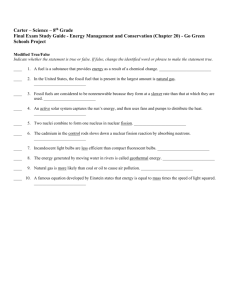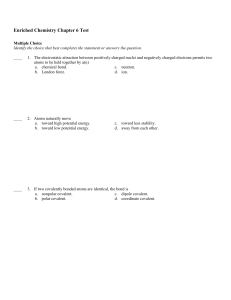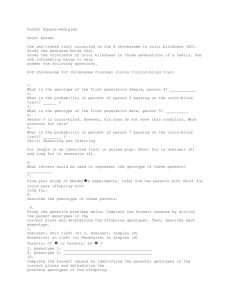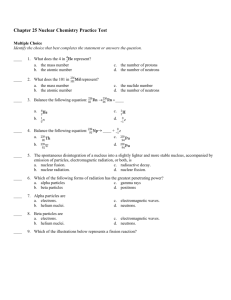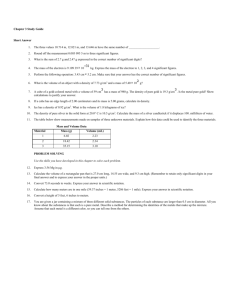Modern Genetics
advertisement
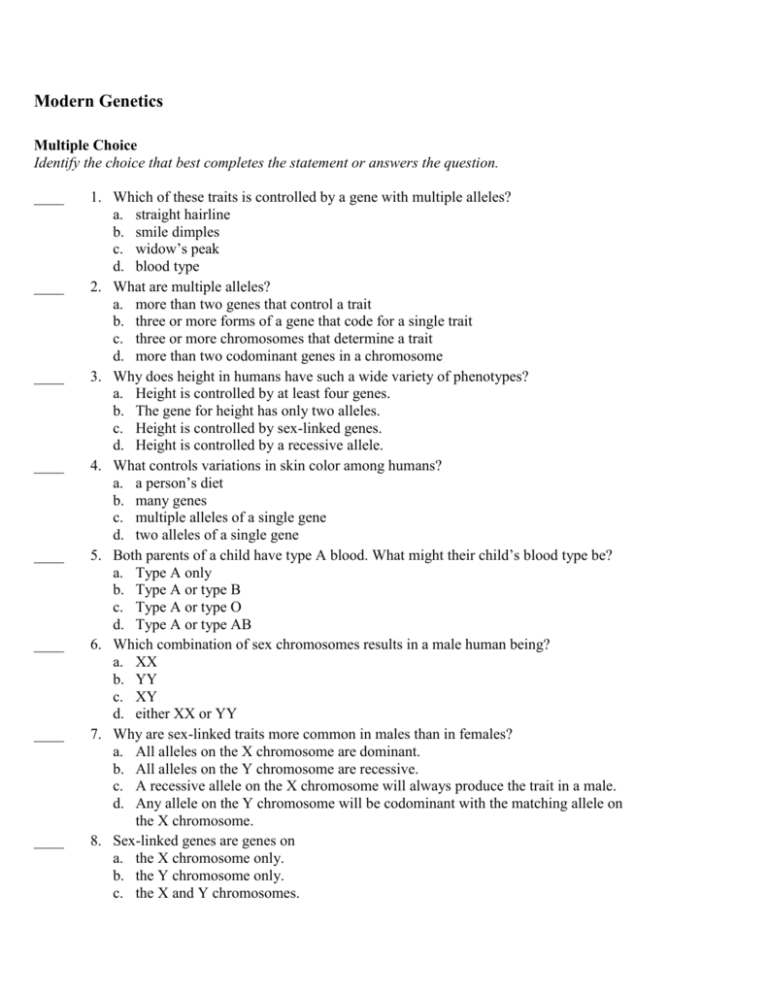
Modern Genetics Multiple Choice Identify the choice that best completes the statement or answers the question. ____ ____ ____ ____ ____ ____ ____ ____ 1. Which of these traits is controlled by a gene with multiple alleles? a. straight hairline b. smile dimples c. widow’s peak d. blood type 2. What are multiple alleles? a. more than two genes that control a trait b. three or more forms of a gene that code for a single trait c. three or more chromosomes that determine a trait d. more than two codominant genes in a chromosome 3. Why does height in humans have such a wide variety of phenotypes? a. Height is controlled by at least four genes. b. The gene for height has only two alleles. c. Height is controlled by sex-linked genes. d. Height is controlled by a recessive allele. 4. What controls variations in skin color among humans? a. a person’s diet b. many genes c. multiple alleles of a single gene d. two alleles of a single gene 5. Both parents of a child have type A blood. What might their child’s blood type be? a. Type A only b. Type A or type B c. Type A or type O d. Type A or type AB 6. Which combination of sex chromosomes results in a male human being? a. XX b. YY c. XY d. either XX or YY 7. Why are sex-linked traits more common in males than in females? a. All alleles on the X chromosome are dominant. b. All alleles on the Y chromosome are recessive. c. A recessive allele on the X chromosome will always produce the trait in a male. d. Any allele on the Y chromosome will be codominant with the matching allele on the X chromosome. 8. Sex-linked genes are genes on a. the X chromosome only. b. the Y chromosome only. c. the X and Y chromosomes. ____ 9. ____ 10. ____ 11. ____ 12. ____ 13. ____ 14. ____ 15. ____ 16. d. all 23 pairs of chromosomes. A carrier is a person who has a. one recessive and one dominant allele for a trait. b. two recessive alleles for a trait. c. two dominant alleles for a trait. d. more than two alleles for a trait. The Human Genome Project’s main goal has been to identify the DNA sequence of every gene in the human genome. How might knowing this be useful in gene therapy? a. Knowing the entire human genome may allow scientists to use bacterial cells to produce human insulin b. Knowing the DNA sequence of the entire human genome may make it easier for doctors to identify defective alleles in an individual and to treat some genetic disorders. c. Scientist may develop a method that allows cows to produce greater quantities of milk as a result of knowing the entire human genome. d. The Human Genome Project will likely have no affect on gene therapy. Which of these human traits is altered by variations in environment? a. hairline b. height c. smile dimples d. blood type What factors can affect a person’s height? a. genes only b. both genes and environmental factors c. a person’s blood type d. a person’s karyotype Many characteristics are affected by interactions between genes and a. chromosomes. b. the environment. c. alleles. d. carriers. Genetic disorders are caused by a. pedigrees. b. DNA mutations or changes in chromosomes. c. dominant alleles only. d. recessive alleles only. Which genetic disorder causes the body to produce unusually thick mucus in the lungs and intestines? a. hemophilia b. Down syndrome c. cystic fibrosis d. sickle-cell disease Hemophilia is caused by a(n) a. recessive allele on the X chromosome. b. extra chromosome. ____ 17. ____ 18. ____ 19. ____ 20. ____ 21. ____ 22. ____ 23. ____ 24. ____ 25. c. dominant allele. d. codominant allele. Down syndrome most often occurs when a. a person inherits a recessive allele. b. chromosomes fail to separate properly during meiosis. c. sickle-shaped cells become stuck in blood vessels. d. blood fails to clot properly. What genetic disorder results in abnormally shaped blood cells? a. hemophilia b. Down syndrome c. cystic fibrosis d. sickle-cell disease How does a geneticist use pedigrees? a. to create genetic crosses b. to replicate identical strings of DNA c. to prove that sex-linked traits are caused by codominant alleles d. to trace the inheritance of traits in humans What is a pedigree? a. a chart that tracks which members of a family have a particular trait b. a geneticist who studies the inheritance of traits in humans c. a picture of all of the chromosomes in a cell d. an allele passed from parent to child on a sex chromosome What is a karyotype? a. a sex-linked genetic disorder b. a picture of a baby before it is born c. a picture of the chromosomes in a cell d. fluid that surrounds a baby before it is born What would be the best way to predict the probability of a baby having cystic fibrosis? a. by studying the parents’ karyotypes b. by studying the family’s pedigree chart c. by exploring new methods of genetic engineering d. by determining whether the parents have codominant alleles Adults with Down syndrome can often find work because they have received a. folic acid. b. physical therapy. c. education and job training. d. genetic counseling. Cloning results in two organisms that are a. both adult mammals. b. produced from cuttings. c. genetically similar. d. genetically identical. Which of these is an example of the benefits of genetic engineering? a. cross-breeding to create disease-resistant crops b. creating human insulin to treat people with diabetes ____ 26. ____ 27. ____ 28. ____ 29. ____ 30. c. analyzing karyotypes and pedigree charts d. growing a new plant from a cutting In an attempt to produce a potato that tastes good and also resists disease, plant breeders crossed a potato variety that tastes good with a variety that resists disease. This technique is an example of a. genetic engineering. b. inbreeding. c. hybridization. d. cloning. Which form of selective breeding crosses parents with the same or similar sets of alleles? a. fertilization b. inbreeding c. hybridization d. cloning A woman gives birth to a son who is red-green colorblind. Her daughter is also red-green colorblind. What can you conclude about the family’s pedigree? a. The father must be colorblind, and the mother must carry one recessive allele for colorblindness. b. The father must be colorblind, but the mother carries two dominant genes for normal vision. c. The mother must be colorblind, and the father must carry one recessive allele for colorblindness. d. The father must be colorblind, and the mother must carry two dominant genes for colorblindness. You are able to tell a person’s sex by looking at his or her karyotype because a karyotype a. shows sex-linked disorders. b. is a picture of a person’s genes. c. shows a person’s genotype. d. shows the sex chromosomes. Each individual has unique fingerprints. What might you conclude about the inheritance of fingerprint patterns? a. Fingerprint patterns are sex-linked genes. b. Fingerprint patterns are determined by multiple genes. c. Fingerprint patterns are influenced by environmental factors. d. Fingerprint patterns are determined by multiple alleles on the same gene. Modified True/False Indicate whether the statement is true or false. If false, change the identified word or phrase to make the statement true. ____ 31. Even if a gene has multiple alleles, a person cannot have more than three of those alleles. _________________________ ____ 32. Traits that have many different phenotypes, such as height and skin color, are often controlled by a single gene. _________________________ ____ 33. Sex-linked traits that are controlled by recessive alleles are more likely to show up in males. _________________________ ____ 34. A person’s environment can affect his or her genotype for certain traits, such as height. _________________________ ____ 35. A genetic disorder in which an abnormal form of hemoglobin is produced is hemophilia. _________________________ ____ 36. A male is represented by a square in a pedigree. _________________________ ____ 37. Down syndrome can be diagnosed using a karyotype. _________________________ ____ 38. The technique called cloning produces an organism that is genetically identical to its parent. _________________________ ____ 39. To create bacteria that produce insulin, a section of DNA is inserted into a bacterium’s chromosome. _____________ ____ 40. A genetic counselor can help explain the risks of having a child with a disorder to couples who have a family history of genetic disorders. __________________ Completion Complete each statement. 41. The three alleles on the single gene that controls blood type are said to be ____________________ alleles. 42. When many genes control a trait, the trait will show a large number of ____________________. 43. A gene is said to have multiple alleles if it has more than ____________________ alleles. 44. An egg that is fertilized by a sperm cell with a(n) ____________________ chromosome will develop into a female. 45. A carrier is a person who has one ____________________ allele for a trait. 46. Improvements in ____________________ can alter the effects of genes on height. 47. A person’s surroundings, or ____________________, can change the effects of a person’s genes. 48. People who have the genetic disorder called ____________________ suffer from abnormally low levels of oxygen in the blood. 49. A person who has the genetic disorder called ____________________ bleeds easily. 50. Down’s syndrome is caused by the presence of an extra ____________________. 51. A(n) ____________________ is used to track the occurrence of a trait in a family. 52. A karyotype can be used to diagnose the genetic disorder called ____________________. 53. A genetic counselor uses kayotypes, Punnett squares, and ____________________ to help couples understand their chances of having a child with a genetic disorder. 54. A karyotype can be used to determine the number of ____________________ in a person’s cells. 55. Breeders use a technique called ____________________ to cross genetically different individuals. 56. A gene from one organism is inserted into the DNA of another organism in the process known as _________________________. 57. A selective breeding technique called ____________________ has been used to breed purebred racehorses. 58. If you see two DNA fingerprints that are exactly the same but come from different individuals, you know you are looking at the DNA fingerprints of ______________. 59. Many people with genetic disorders can live active and productive lives if they modify factors in their _______________ such as diet, medicine, and/or education. 60. In a country experiencing several consecutive years of famine, you might expect growing children to be _____________ than their genes for height suggest, due to the environmental factor of poor nutrition. Short Answer Use the diagram to answer each question. 61. Could the trait that is traced by this pedigree be sex-linked? Explain why or why not. 62. What do the circles in the pedigree represent? What do the squares represent? 63. Which pairs of individuals in the pedigree have children? 64. Which individuals have the trait that is traced by the pedigree? 65. Which individuals are carriers of the trait that is traced by the pedigree? 66. Which individuals neither have the trait nor are carriers? Use the diagram to answer each question. 67. Identify structures A and B. What do these structures contain? 68. Explain what is happening in Step 1. 69. Explain what is happening in Step 2. 70. Explain what is happening in Step 3. 71. Explain what is happening in Step 4. 72. Why are bacteria often used in genetic engineering? Essay 73. Human eyes come in a variety of colors ranging from light blue to very dark brown. Explain why eye color is not likely to be controlled by a single gene. 74. A person with blood type AB has the alleles IA and IB. A person with blood type O has the alleles ii. Is it possible for a person with blood type AB to have a child with blood type O? Explain why or why not. 75. Is it possible for a son to inherit an allele on an X chromosome from his father? Explain why or why not. 76. Explain what causes cystic fibrosis and describe its effects on the body. 77. Archaeologists and geneticists use DNA from mummies to trace the complicated relationships among Ancient Egyptian kings and queens, following patterns of descent from one generation to the next. What kind of DNA is used, and how do you know? 78. A plant breeder clones a plant with beautiful flowers. Define cloning and explain how the cloned offspring compare to the parent plant. 79. Contrast hybridization and inbreeding. 80. In the 1900s, hemophilia was commonly found in European royal families, most of which were descended from a common ancestor. Royal marriages were frequently between cousins, in order to keep the royal blood ‘pure.’ What type of selective is this an example of? Explain how this practice contributed to cases of hemophilia in European royal families. Modern Genetics Answer Section MULTIPLE CHOICE 1. ANS: OBJ: STA: 2. ANS: OBJ: STA: 3. ANS: OBJ: STA: 4. ANS: OBJ: STA: 5. ANS: OBJ: STA: 6. ANS: OBJ: STA: 7. ANS: OBJ: STA: 8. ANS: OBJ: STA: 9. ANS: OBJ: STA: 10. ANS: OBJ: STA: 11. ANS: OBJ: STA: 12. ANS: OBJ: STA: 13. ANS: OBJ: STA: D PTS: 1 DIF: L1 CaLS.6.1.1 Identify some patterns of inheritance in humans. S 7.2 BLM: knowledge B PTS: 1 DIF: L1 CaLS.6.1.1 Identify some patterns of inheritance in humans. S 7.2.c BLM: knowledge A PTS: 1 DIF: L2 CaLS.6.1.1 Identify some patterns of inheritance in humans. S 7.2.c BLM: comprehension B PTS: 1 DIF: L1 CaLS.6.1.1 Identify some patterns of inheritance in humans. S 7.2.c BLM: knowledge C PTS: 1 DIF: L2 CaLS.6.1.1 Identify some patterns of inheritance in humans. S 7.2.c BLM: analysis C PTS: 1 DIF: L1 CaLS.6.1.2 Describe the functions of the sex chromosomes. S 7.2.c BLM: knowledge C PTS: 1 DIF: L2 CaLS.6.1.2 Describe the functions of the sex chromosomes. S 7.2.c BLM: comprehension C PTS: 1 DIF: L1 CaLS.6.1.2 Describe the functions of the sex chromosomes. S 7.2.c BLM: knowledge A PTS: 1 DIF: L1 CaLS.6.1.2 Describe the functions of the sex chromosomes. S 7.2.c BLM: knowledge B PTS: 1 DIF: L3 CaLS.6.3.2 Identify two applications of DNA technology in human genetics. S 7.2.c BLM: synthesis B PTS: 1 DIF: L1 CaLS.6.1.3 Explain the relationship between genes and the environment. S 7.2 BLM: knowledge B PTS: 1 DIF: L2 CaLS.6.1.3 Explain the relationship between genes and the environment. S 7.2 BLM: comprehension B PTS: 1 DIF: L1 CaLS.6.1.3 Explain the relationship between genes and the environment. S 7.2 BLM: knowledge 14. ANS: OBJ: STA: 15. ANS: OBJ: STA: 16. ANS: OBJ: STA: 17. ANS: OBJ: STA: 18. ANS: OBJ: STA: 19. ANS: OBJ: STA: 20. ANS: OBJ: STA: 21. ANS: OBJ: STA: 22. ANS: OBJ: STA: 23. ANS: OBJ: STA: 24. ANS: OBJ: STA: 25. ANS: OBJ: STA: 26. ANS: OBJ: STA: 27. ANS: OBJ: STA: 28. ANS: OBJ: BLM: B PTS: 1 DIF: L1 CaLS.6.2.1 Identify two major causes of genetic disorders in humans. S 7.2.d BLM: knowledge C PTS: 1 DIF: L1 CaLS.6.2.1 Identify two major causes of genetic disorders in humans. S 7.2.d BLM: knowledge A PTS: 1 DIF: L1 CaLS.6.2.1 Identify two major causes of genetic disorders in humans. S 7.2.d BLM: knowledge B PTS: 1 DIF: L1 CaLS.6.2.1 Identify two major causes of genetic disorders in humans. S 7.2.d BLM: knowledge D PTS: 1 DIF: L1 CaLS.6.2.1 Identify two major causes of genetic disorders in humans. S 7.2.d BLM: knowledge D PTS: 1 DIF: L1 CaLS.6.2.2 Explain how geneticists trace the inheritance of traits. S 7.2.b BLM: knowledge A PTS: 1 DIF: L1 CaLS.6.2.2 Explain how geneticists trace the inheritance of traits. S 7.2.b BLM: knowledge C PTS: 1 DIF: L1 CaLS.6.2.3 Describe how genetic disorders are diagnosed and treated. S 7.2.d BLM: knowledge B PTS: 1 DIF: L2 CaLS.6.2.3 Describe how genetic disorders are diagnosed and treated. S 7.2.b BLM: comprehension C PTS: 1 DIF: L1 CaLS.6.2.3 Describe how genetic disorders are diagnosed and treated. S 7.2.d BLM: knowledge D PTS: 1 DIF: L2 CaLS.6.3.1 Describe three ways of producing organisms with desired traits. S 7.2.a BLM: comprehension B PTS: 1 DIF: L2 CaLS.6.3.1 Describe three ways of producing organisms with desired traits. S 7.5.b BLM: comprehension C PTS: 1 DIF: L2 CaLS.6.3.1 Describe three ways of producing organisms with desired traits. S 7.2.b BLM: application B PTS: 1 DIF: L1 CaLS.6.3.1 Describe three ways of producing organisms with desired traits. S 7.2.b BLM: knowledge A PTS: 1 DIF: L3 CaLS.6.2.2 Explain how geneticists trace the inheritance of traits. application 29. ANS: OBJ: BLM: 30. ANS: OBJ: BLM: D PTS: 1 DIF: L3 CaLS.6.2.3 Describe how genetic disorders are diagnosed and treated. synthesis B PTS: 1 DIF: L2 CaLS.6.1.1 Identify some patterns of inheritance in humans. application MODIFIED TRUE/FALSE 31. ANS: F, two PTS: OBJ: STA: 32. ANS: 1 DIF: L2 CaLS.6.1.1 Identify some patterns of inheritance in humans. S 7.2.d BLM: application F, many genes PTS: OBJ: STA: 33. ANS: OBJ: STA: 34. ANS: 1 DIF: L2 CaLS.6.1.1 Identify some patterns of inheritance in humans. S 7.2.c BLM: comprehension T PTS: 1 DIF: CaLS.6.1.2 Describe the functions of the sex chromosomes. S 7.2.c BLM: knowledge F, phenotype PTS: OBJ: STA: 35. ANS: 1 DIF: L1 CaLS.6.1.3 Explain the relationship between genes and the environment. S 7.2 BLM: knowledge F, sickle-cell disease 36. 37. 38. 39. PTS: OBJ: STA: ANS: OBJ: STA: ANS: OBJ: STA: ANS: OBJ: STA: ANS: L1 1 DIF: L1 CaLS.6.2.1 Identify two major causes of genetic disorders in humans. S 7.2.d BLM: knowledge T PTS: 1 DIF: L1 CaLS.6.2.2 Explain how geneticists trace the inheritance of traits. S 7.2.b BLM: knowledge T PTS: 1 DIF: L2 CaLS.6.2.3 Describe how genetic disorders are diagnosed and treated. S 7.2.d BLM: comprehension T PTS: 1 DIF: L1 CaLS.6.3.1 Describe three ways of producing organisms with desired traits. S 7.2.a BLM: knowledge F, plasmid PTS: 1 DIF: L2 OBJ: CaLS.6.3.2 Identify two applications of DNA technology in human genetics. BLM: 40. ANS: OBJ: BLM: comprehension T PTS: 1 DIF: L2 CaLS.6.2.3 Describe how genetic disorders are diagnosed and treated. comprehension COMPLETION 41. ANS: multiple PTS: OBJ: STA: 42. ANS: 1 DIF: L1 CaLS.6.1.1 Identify some patterns of inheritance in humans. S 7.2.c BLM: knowledge phenotypes PTS: 1 DIF: L2 OBJ: CaLS.6.1.1 Identify some patterns of inheritance in humans. STA: S 7.2.c BLM: comprehension 43. ANS: two 2 PTS: OBJ: STA: 44. ANS: 1 DIF: L1 CaLS.6.1.1 Identify some patterns of inheritance in humans. S 7.2.c BLM: knowledge X PTS: OBJ: STA: 45. ANS: 1 DIF: L2 CaLS.6.1.2 Describe the functions of the sex chromosomes. S 7.2.a BLM: application recessive PTS: OBJ: STA: 46. ANS: 1 DIF: L1 CaLS.6.1.2 Describe the functions of the sex chromosomes. S 7.2.d BLM: knowledge diet PTS: OBJ: STA: 47. ANS: 1 DIF: L2 CaLS.6.1.3 Explain the relationship between genes and the environment. S 7.2 BLM: application environment PTS: 1 DIF: L2 OBJ: CaLS.6.1.3 Explain the relationship between genes and the environment. STA: S 7.2 BLM: comprehension 48. ANS: sickle-cell disease sickle cell disease PTS: OBJ: STA: 49. ANS: 1 DIF: L1 CaLS.6.2.1 Identify two major causes of genetic disorders in humans. S 7.2.d BLM: knowledge hemophilia PTS: OBJ: STA: 50. ANS: 1 DIF: L1 CaLS.6.2.1 Identify two major causes of genetic disorders in humans. S 7.2.d BLM: knowledge chromosome PTS: OBJ: STA: 51. ANS: 1 DIF: L1 CaLS.6.2.1 Identify two major causes of genetic disorders in humans. S 7.2.d BLM: knowledge pedigree PTS: OBJ: STA: 52. ANS: 1 DIF: L1 CaLS.6.2.2 Explain how geneticists trace the inheritance of traits. S 7.2.b BLM: knowledge Down syndrome PTS: OBJ: STA: 53. ANS: 1 DIF: L2 CaLS.6.2.3 Describe how genetic disorders are diagnosed and treated. S 7.2.d BLM: comprehension pedigree charts PTS: OBJ: STA: 54. ANS: 1 DIF: L2 CaLS.6.2.3 Describe how genetic disorders are diagnosed and treated. S 7.2.d BLM: comprehension chromosomes PTS: OBJ: STA: 55. ANS: 1 DIF: L1 CaLS.6.2.3 Describe how genetic disorders are diagnosed and treated. S 7.2.d BLM: knowledge hybridization PTS: OBJ: STA: 56. ANS: 1 DIF: L1 CaLS.6.3.1 Describe three ways of producing organisms with desired traits. S 7.2.b BLM: knowledge genetic engineering PTS: 1 DIF: L1 OBJ: CaLS.6.3.1 Describe three ways of producing organisms with desired traits. STA: S 7.2.b BLM: knowledge 57. ANS: inbreeding PTS: OBJ: STA: 58. ANS: 1 DIF: L1 CaLS.6.3.1 Describe three ways of producing organisms with desired traits. S 7.2.b BLM: knowledge identical twins. PTS: OBJ: BLM: 59. ANS: 1 DIF: L2 CaLS.6.3.2 Identify two applications of DNA technology in human genetics. comprehension environment PTS: OBJ: BLM: 60. ANS: 1 DIF: L2 CaLS.6.2.3 Describe how genetic disorders are diagnosed and treated. comprehension shorter PTS: 1 DIF: L3 OBJ: CaLS.6.1.3 Explain the relationship between genes and the environment. BLM: synthesis SHORT ANSWER 61. ANS: Yes, the trait could be sex-linked. All of the individuals who have the trait are male, and all of the carriers are female. These characteristics are typical of traits that are controlled by genes on the X chromosome. PTS: 1 DIF: L2 OBJ: CaLS.6.1.2 Describe the functions of the sex chromosomes. STA: S 7.2.b BLM: analysis 62. ANS: The circles represent females. The squares represent males. PTS: 1 DIF: L2 OBJ: CaLS.6.2.2 Explain how geneticists trace the inheritance of traits. STA: S 7.2.b BLM: comprehension 63. ANS: Pair A and B, pair C and D, pair F and G, and pair H and I have children. PTS: 1 DIF: L2 OBJ: CaLS.6.2.2 Explain how geneticists trace the inheritance of traits. STA: S 7.2.d BLM: analysis 64. ANS: F and J have the trait. PTS: 1 DIF: L2 OBJ: CaLS.6.2.2 Explain how geneticists trace the inheritance of traits. STA: S 7.2.d BLM: analysis 65. ANS: A, C, N, and O are carriers of the trait. PTS: 1 DIF: L2 OBJ: CaLS.6.2.2 Explain how geneticists trace the inheritance of traits. STA: S 7.2.d BLM: analysis 66. ANS: B, D, E, G, H, I, K, L, M, P, and Q do not have the trait and are not carriers. PTS: 1 DIF: L2 OBJ: CaLS.6.2.2 Explain how geneticists trace the inheritance of traits. STA: S 7.2.d BLM: analysis 67. ANS: A is a plasmid, and B is the bacterial chromosome. Both structures contain DNA. PTS: 1 DIF: L2 OBJ: CaLS.6.3.1 Describe three ways of producing organisms with desired traits. STA: S 7.2.e BLM: comprehension 68. ANS: An enzyme is cutting open the plasmid and is removing a gene from the human DNA. PTS: 1 DIF: L2 OBJ: CaLS.6.3.1 Describe three ways of producing organisms with desired traits. STA: S 7.2.e BLM: comprehension 69. ANS: The human gene is attaching to the open ends of the plasmid and forming a closed ring. PTS: 1 DIF: L2 OBJ: CaLS.6.3.1 Describe three ways of producing organisms with desired traits. STA: S 7.2.e BLM: comprehension 70. ANS: The plasmid containing the human gene is being taken up by a bacterial cell. PTS: 1 DIF: L2 OBJ: CaLS.6.3.1 Describe three ways of producing organisms with desired traits. STA: S 7.2.b BLM: comprehension 71. ANS: The bacterial cell is reproducing to make new bacteria, each with a plasmid containing the human gene. PTS: 1 DIF: L2 OBJ: CaLS.6.3.1 Describe three ways of producing organisms with desired traits. STA: S 7.2.b BLM: comprehension 72. ANS: Bacteria reproduce quickly. In a short time they can produce large amounts of the protein coded for by the gene that has been attached to the plasmid. PTS: 1 DIF: L3 OBJ: CaLS.6.3.1 Describe three ways of producing organisms with desired traits. STA: S 7.2.b BLM: synthesis ESSAY 73. ANS: Traits that show a large number of phenotypes are usually controlled by many genes. With multiple genes and two or more alleles for each gene, there are many possible combinations of alleles and phenotypes. PTS: 1 DIF: L3 OBJ: CaLS.6.1.1 Identify some patterns of inheritance in humans. STA: S 7.2.c BLM: synthesis 74. ANS: No, it is not possible. A person with blood type O receives one allele from each parent. The offspring of a person with blood type AB would inherit either an IA or an IB allele. A person with blood type O must inherit an i allele from each parent. PTS: 1 DIF: L3 OBJ: CaLS.6.1.1 Identify some patterns of inheritance in humans. STA: S 7.2.c BLM: application 75. ANS: It is not possible because males only have one X chromosome, which always comes from the mother. PTS: 1 DIF: L2 OBJ: CaLS.6.1.2 Describe the functions of the sex chromosomes. STA: S 7.2.c BLM: analysis 76. ANS: Cystic fibrosis is caused by a recessive allele that causes the body to produce abnormally thick mucus in the lungs and intestines. People with cystic fibrosis have difficulty breathing. PTS: 1 DIF: L2 OBJ: CaLS.6.2.1 Identify two major causes of genetic disorders in humans. STA: S 7.2.d BLM: comprehension 77. ANS: Mitochondrial DNA is used. Mitochondrial DNA is passed from a mother to her children and can therefore be used to trace the relationship between a woman and her descendants. PTS: 1 DIF: L3 OBJ: CaLS.6.3.2 Identify two applications of DNA technology in human genetics. STA: S 7.2.d BLM: application 78. ANS: Cloning produces an organism that is genetically identical to the organism from which it was produced. The offspring of this plant would look exactly like the parent plant. PTS: 1 DIF: L2 OBJ: CaLS.6.3.1 Describe three ways of producing organisms with desired traits. STA: S 7.2.a BLM: application 79. ANS: Hybridization is the process in which breeders cross two genetically different individuals. Inbreeding involves crossing two individuals that have the same or similar sets of alleles. PTS: 1 DIF: L2 OBJ: CaLS.6.3.1 Describe three ways of producing organisms with desired traits. STA: S 7.2.b BLM: analysis 80. ANS: Intermarriage between close relatives is an example of inbreeding. In this case, the desired trait was purity of royal bloodlines. Because inbred organisms have very similar genetic composition, inbreeding increases the risk of genetic disorders. In the case of hemophilia, which is a sex-linked disorder caused by a recessive allele on the X chromosome, one woman could have passed the gene to both a son and a daughter. If these children passed the genes to their children, and their children married each other, the likelihood that the resulting children would have hemophilia would be very high. PTS: 1 DIF: L3 OBJ: CaLS.6.2.2 Explain how geneticists trace the inheritance of traits. STA: S 7.2.c BLM: synthesis



